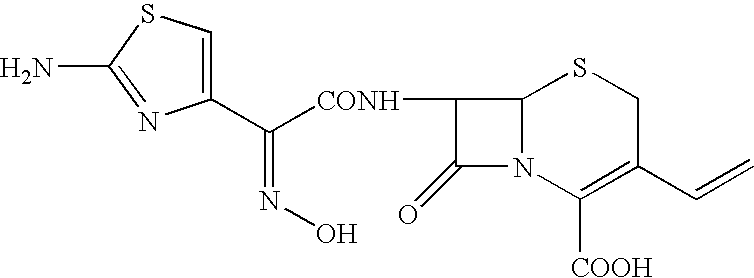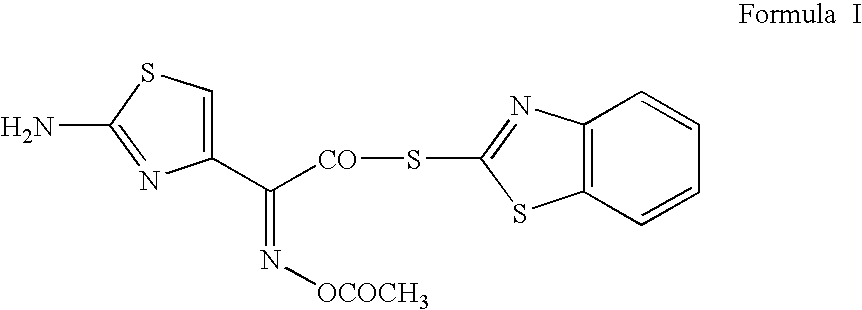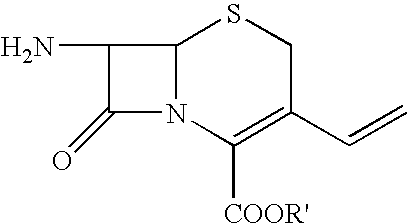Process for preparing cefdinir
a cephalosporin and cephalosporin technology, applied in the field of oral, semi-synthetic cephalosporin antibiotics, can solve the problems of low yielding step and isolation involving chromatography, hydrochloride not proved, and raw materials not easily availabl
- Summary
- Abstract
- Description
- Claims
- Application Information
AI Technical Summary
Benefits of technology
Problems solved by technology
Method used
Image
Examples
example 1
PREPARATION OF 2-MERCAPTOBENZOTHIAZOLYL (Z)-2-(2-AMINO-4-THIAZOLYL)-2-ACETYLOXYIMINOACETATE (O-ACETYL THIOESTER)
[0031]55 g of (Z)-2-(2-amino-4-thiazolyl)-2-acetyloxyiminoacetic acid (0.240 mol, moisture content: 0.49% w / w) was added to 825 ml of methylene dichloride at 20° C. Cooled the reaction mass to 15–20° C. To this mixture, 111.6 g of bis(benzothiazol-2-yl)disulphide (0.336 mol) and 91.2 g of triphenylphospine (0.348 mol) were added at 10–15° C. To this reaction mixture, 34 g of triethylamine (0.336 mol) was added at 10–15° C. during a period of 5–10 min. Maintained the reaction mass temperature at 10–30° C. till starting material is ≦2% by qualitative HPLC analysis (˜1 h). Cooled the reaction mixture to 5–10° C. and filtered the precipitated product. Washed with 300 ml of methylene dichloride at 5–10° C. Dried the product at 35–40° C. under reduced pressure till LOD≦1% w / w. 74 g of product was isolated which showed greater than 94% purity by HPLC with a melting point of 143–1...
example 2
PREPARATION OF 7β-[(Z)-2-(2-AMINO-4-THIAZOLYL)-2-HYDROXYIMINO ACETAMIDO]-3-VINYL-3-CEPHEM-4-CARBOXYLIC ACID (CEFDINIR)
[0033]40 g of 7-amino-3-vinyl-3-cephem-4-carboxylic acid (AVNA, 0.177 mol) was added to 400 ml of tetrahydrofuran under nitrogen atmosphere followed by 78 g of O-acetyl thioester (0.206 mol, prepared in Example 1) and 200 ml of water with stirring. Cooled the reaction mass to 15–20° C. To this reaction mixture, 20 g of triethylamine was added slowly at pH ˜8.5. Stirring was continued and progress of the reaction was monitored by qualitative HPLC till AVNA was less than 1%. At this stage 400 ml of methylene dichloride was added and stirred for further 15 min at 20–25° C. 200 ml of water was added and stirred the reaction mass for 15 min at 20–25° C. Separated the layers and to the aqueous layer, 20% w / v aqueous potassium carbonate solution was added and maintained pH at 8.1–8.2 at 20–25° C. Thereafter, 26.4 g of ammonium chloride was added in one lot at 20–25° C. and ...
PUM
| Property | Measurement | Unit |
|---|---|---|
| temperature | aaaaa | aaaaa |
| temperature | aaaaa | aaaaa |
| temperature | aaaaa | aaaaa |
Abstract
Description
Claims
Application Information
 Login to View More
Login to View More - R&D
- Intellectual Property
- Life Sciences
- Materials
- Tech Scout
- Unparalleled Data Quality
- Higher Quality Content
- 60% Fewer Hallucinations
Browse by: Latest US Patents, China's latest patents, Technical Efficacy Thesaurus, Application Domain, Technology Topic, Popular Technical Reports.
© 2025 PatSnap. All rights reserved.Legal|Privacy policy|Modern Slavery Act Transparency Statement|Sitemap|About US| Contact US: help@patsnap.com



